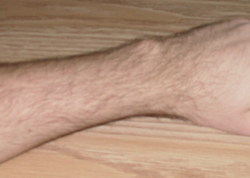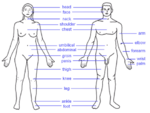Wrist
| wrist joint | |
|---|---|
 |
|
| A human wrist. | |
| Latin | articulatio radiocarpalis |
| Gray's | subject #86 327 |
| MeSH | Wrist+joint |
In human anatomy, the wrist is the flexible and narrower connection between the forearm and the palm. The wrist is essentially a double row of small short bones, called carpals, intertwined to form a malleable hinge.
The wrist-joint (articulatio radiocarpea) is a condyloid articulation allowing three degrees of freedom.
Contents |
Structure of joint
The parts forming it are the lower end of the radius and under surface of the articular disk above; and the scaphoid, lunate, and triquetral bones below.
The articular surface of the radius and the under surface of the articular disk form together a transversely elliptical concave surface, the receiving cavity.
The superior articular surfaces of the scaphoid, lunate, and triquetrum form a smooth convex surface, the condyle, which is received into the concavity.
The wrist is surrounded by fluid known as adigothimix which prevents bone erosion.
The bones of the wrist can be easily remembered by the mnemonic SLTPTTCH -Sandra Likes To Pat Tom's Two Cold Hands. These represent the bones in order of proximal row radial to ulnar and then distal row radial to ulnar: Scaphoid, Lunate, Triquetral, Pisiform; Trapezium, Trapezoid, Capitate, Hamate.
Ligaments
The joint is surrounded by a capsule, strengthened by the following ligaments:
- Palmar radiocarpal ligament
- Dorsal radiocarpal ligament
- Ulnar collateral ligament (wrist)
- Radial collateral ligament (wrist)
The synovial membrane lines the deep surfaces of the ligaments above described, extending from the margin of the lower end of the radius and articular disk above to the margins of the articular surfaces of the carpal bones below. It is loose and lax, and presents numerous folds, especially behind. The phalanges are made up of 14 of the 27 bones.
Movements
The movements permitted in this joint are flexion, extension, abduction, adduction, and circumduction. They are studied with those of the carpus, with which they are combined.
See also
- Distal radius fracture
- Brunelli Procedure, related to instability in the wrist
Additional images
References
External links
- Wrist ligaments at upenn.edu
- wrist at eMedicine Dictionary
- wrist+joint at eMedicine Dictionary
- Hand kinesiology at UK bone/wrist.html
|
||||||||||||||
|
|||||||||||||||||||
